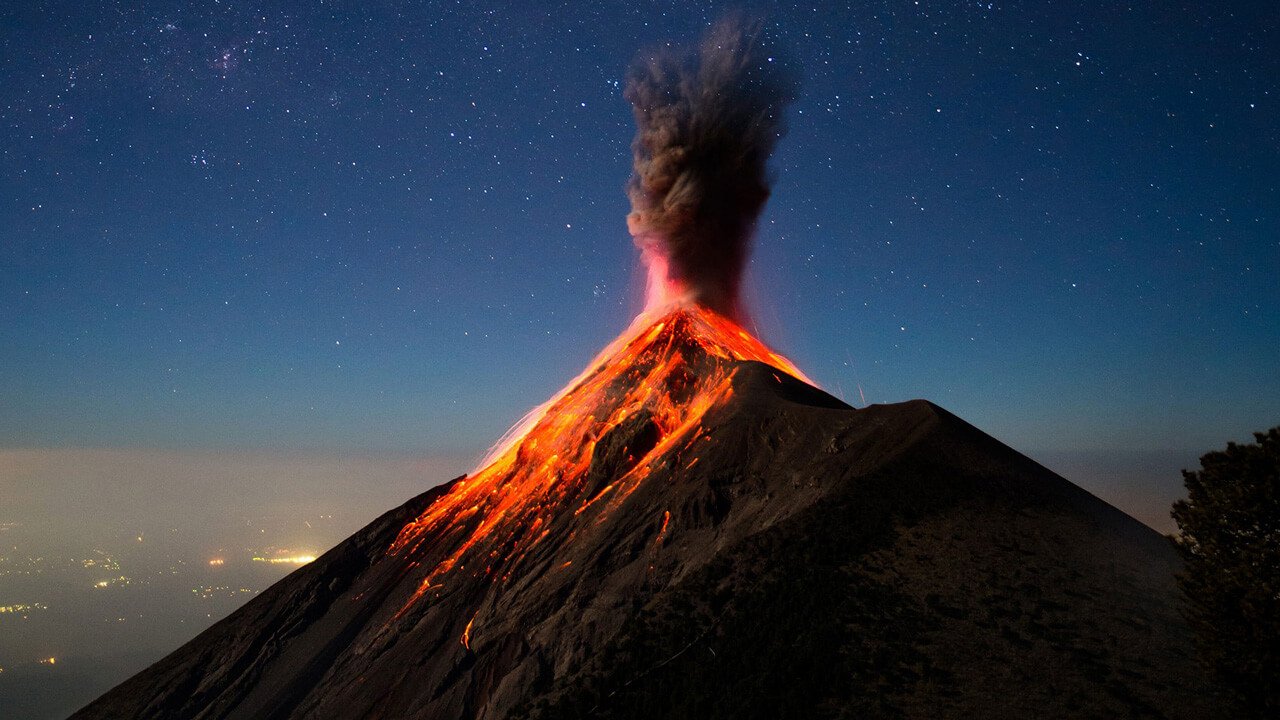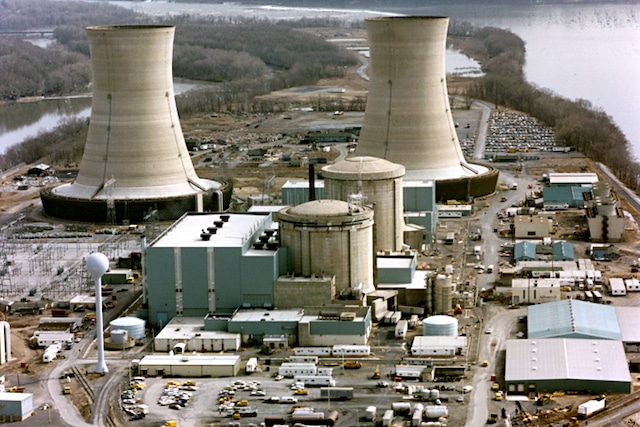Вулканическая активность – одна из сил природы, способных изменить лик Земли. И в настоящий момент подземные силы продолжают свою титаническую работу. Созданные из множества слоев лавы, чудовищных размеров, самые большие вулканы в мире таятся под водной гладью или нависают над расположенными поблизости городами.
Какие их них считаются самыми большими? Ученые до сих пор не пришли к единому мнению. Одни полагают, что выстраивать рейтинг надо согласно высоте над уровнем моря. Другие – что учитывать необходимо площадь, на которую расползаются потоки лавы, формируя новую поверхность. Третьи – что важен прежде всего человеческий фактор: опасность для человеческих поселений.
Поэтому для рейтинга самых больших вулканов на планете Земля мы выбрали представителей всех типов – и самые большие по площади, и самые высокие, и самые опасные действующие и потухшие вулканы.
10. Этна — высота 3 295 метров
 Самый высокий вулкан в Европе находится на острове Сицилия и действует до сих пор. Последнее извержение началось 25.12.2018 года. Из-за частых извержений в точности определить его высоту невозможно – она постоянно меняется. Например, за прошедшие 30 лет Этна «потеряла» в высоте более 20 метров. В настоящий момент она возвышается над островом на 3 295 м.
Самый высокий вулкан в Европе находится на острове Сицилия и действует до сих пор. Последнее извержение началось 25.12.2018 года. Из-за частых извержений в точности определить его высоту невозможно – она постоянно меняется. Например, за прошедшие 30 лет Этна «потеряла» в высоте более 20 метров. В настоящий момент она возвышается над островом на 3 295 м.
Гора славится своим скверным характером – ее склоны испещрены кратерами, откуда раз в пару-тройку месяцев стабильно изливается наружу лава. Примерно раз в столетие извержения бывают более крупными, представляя прямую опасность для населяющих склоны человеческих поселений. Однако упрямых людей это не останавливает – из-за частых извержений почва на склонах горы богата полезными для растений элементами, позволяющими снимать большие урожаи.
9. Эребус — 3 794 метра
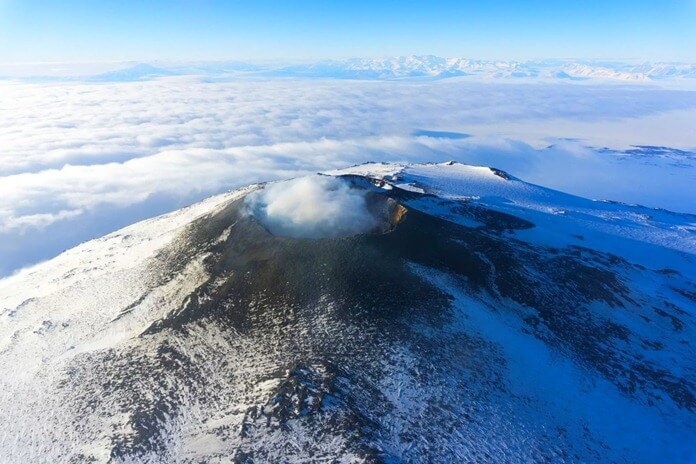 Если остальные вулканы находятся в обжитой части мира, то Эребус расположен на необитаемом материке Антарктида. Это самый большой действующий вулкан южного полярного края. Несмотря на окружающие его безжизненные ледяные пространства, Эребус ведет очень активную жизнь. И его географические положение – аккурат над несколькими разломами земной коры – немало этому способствует.
Если остальные вулканы находятся в обжитой части мира, то Эребус расположен на необитаемом материке Антарктида. Это самый большой действующий вулкан южного полярного края. Несмотря на окружающие его безжизненные ледяные пространства, Эребус ведет очень активную жизнь. И его географические положение – аккурат над несколькими разломами земной коры – немало этому способствует.
Несмотря на то что поблизости от Эребуса люди не живут, он все равно влияет на их жизнь в отрицательном смысле. Из недр вулкана периодически вырываются наружу потоки содержащихся внутри Земли газов, в основном метана и водорода, которые разрушают озоновый слой. Считается, что наименьшая толщина озонового моря аккурат в районе действия вулкана.
8. Ключевская сопка — 4 835 метров
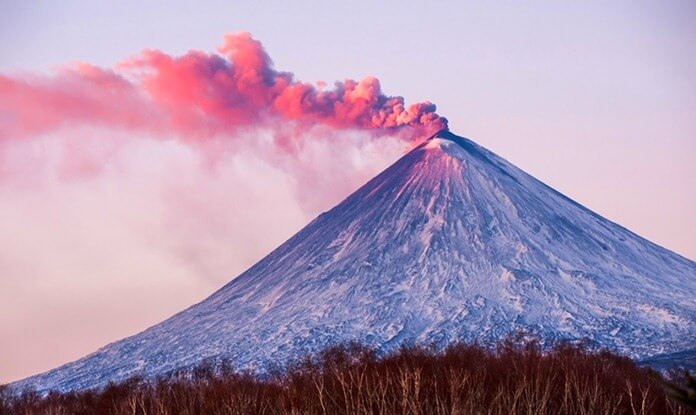 Как и у Этны, высота Ключевского вулкана постоянно меняется. Хотя он и потерял после пятилетней давности извержения около 15 метров, однако по-прежнему остается самым высоким действующим вулканом в России и Азии.
Как и у Этны, высота Ключевского вулкана постоянно меняется. Хотя он и потерял после пятилетней давности извержения около 15 метров, однако по-прежнему остается самым высоким действующим вулканом в России и Азии.
Хотя по сравнению с другими вершинами Камчатки вулкан Ключевского проигрывает в частоте, зато с успехом компенсирует это мощностью. Например, извержение 1938 года продолжалось 13 месяцев и послужило причиной возникновения нескольких кратеров высотой до 1 900 м. А извержение 1980 года оторвало и подбросило в воздух на высоту более 500 м глыбу льда площадью не менее половины километра.
Но самым зрелищным и самым страшным было извержение 1994 года, когда над вулканом поднялся впечатляющий столб пепла высотой более 12 км, а шлейф вулканического пепла простирался от места выброса на многие десятки километров и исчезал где-то в океане.
7. Орисаба — 5 636 метров
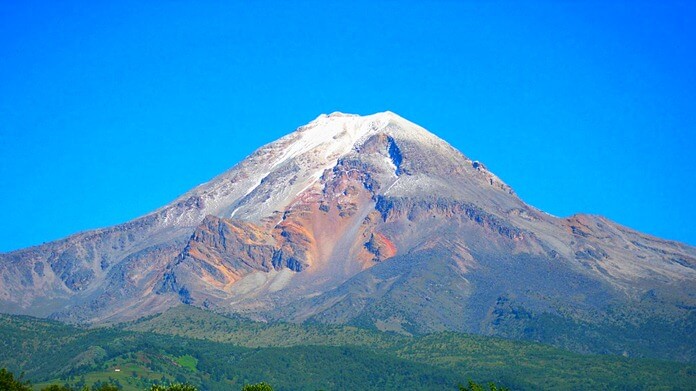 «Должно быть, вершина вулкана касается самого неба», – наверное, думали древние инки и дали ему имя Ситлалтепетль, или «Звездная гора». Это самый высокий действующий вулкан Северной и Центральной Америки, и третья по величине вершина этого региона. Видно его издалека – еще за много миль до берега конус Орисабы можно разглядеть с борта следующего через Мексиканский залив в порт Веракруз судна.
«Должно быть, вершина вулкана касается самого неба», – наверное, думали древние инки и дали ему имя Ситлалтепетль, или «Звездная гора». Это самый высокий действующий вулкан Северной и Центральной Америки, и третья по величине вершина этого региона. Видно его издалека – еще за много миль до берега конус Орисабы можно разглядеть с борта следующего через Мексиканский залив в порт Веракруз судна.
Хотя сейчас вулкан спит, спокойствие его обманчиво – он вел очень активное существование с момента пришествия в эти места конквистадоров вплоть до 19 века, а в последние годы расположенная у его подножия станция фиксировала постоянную внутреннюю активность.
6. Эльбрус — 5 642 метра
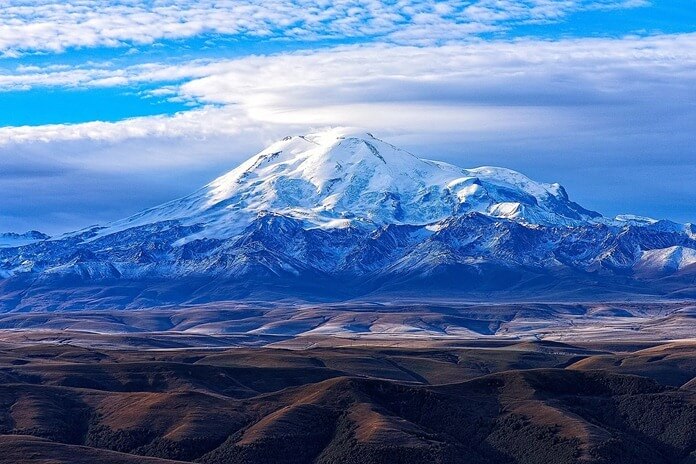 Самая высокая гора одновременно является самым большим вулканом России и Европы. Спускающиеся с заснеженной поверхности ледники дают начало нескольким значимым рекам, питающим равнины Кавказского региона.
Самая высокая гора одновременно является самым большим вулканом России и Европы. Спускающиеся с заснеженной поверхности ледники дают начало нескольким значимым рекам, питающим равнины Кавказского региона.
Помимо красоты, белоснежный конус с двумя вершинами и небольшой седловиной между ними отличается кротким и миролюбивым характером. Эльбрус давно спит, и его последнее извержение было более 5 000 лет назад. Несмотря на внешнюю суровость, забираться на Эльбрус легко и просто – альпинистские маршруты на вершину спящего патриарха одни из самых несложных.
5. Килиманджаро — 5 885 метров
 Великолепный красавец Килиманджаро – визитная карточка Африки, ее самый большой вулкан. Спящий гигант фактически представляет собой три вулканических конуса, которые видны практически из любой точки соседних Танзании и Кении.
Великолепный красавец Килиманджаро – визитная карточка Африки, ее самый большой вулкан. Спящий гигант фактически представляет собой три вулканических конуса, которые видны практически из любой точки соседних Танзании и Кении.
В отличие от многих вулканов рейтинга, Килиманджаро – самый известный вулкан в мире, типичный стратовулкан. Если попросить ребенка изобразить его, скорее всего, он нарисует конической формы гору, с вершины которой извергается пепел, горящие газы и очень вязкая лава, которая быстро застывает, наращивая конус все выше и выше. Это и есть стратовулкан. Величина Килиманджаро – 4 800 км3, а высота его 5 885 м. В последний раз вулкан был активен еще на заре человечества – 360 000 лет назад.
4. Охос-дель-Саладо — 6 893 метра
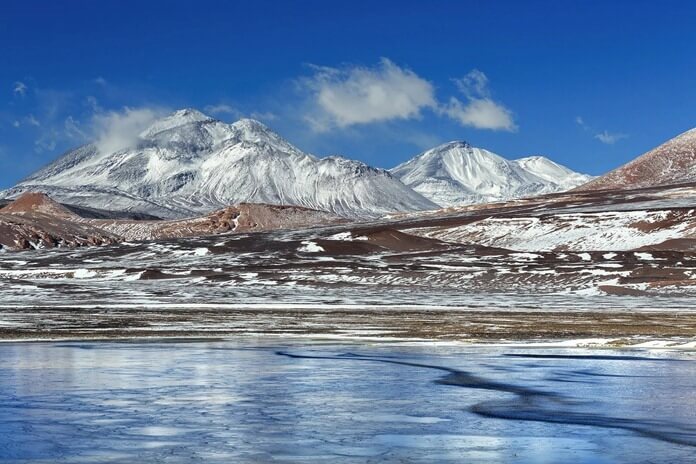 Если второе и третье места рейтинга – самые большие вулканы мира, если считать от морского дна, то Охос-дель-Саладо – это самый высокий вулкан в мире, расположенный над поверхностью моря. Возвышается он на 6 893 м. над землей. Гигантская гора расположена на границе между Аргентиной и Чили.
Если второе и третье места рейтинга – самые большие вулканы мира, если считать от морского дна, то Охос-дель-Саладо – это самый высокий вулкан в мире, расположенный над поверхностью моря. Возвышается он на 6 893 м. над землей. Гигантская гора расположена на границе между Аргентиной и Чили.
Хотя последнее активное извержение вулкана произошло еще до изобретения человечеством письменности – никаких данных о нем не сохранилось – однако Охос-дель-Саладо нельзя назвать спящим в полном смысле слова. В недрах огромной горы словно происходит таинственная скрытая работа, эхо которой доносится до наземных жителей в виде облаков пара и пепла. Последняя такая активность имела место совсем недавно – в 1993 году.
3. Мауна-Лоа — 9 800 метров
 Мауна-Лоа – подводный вулкан, вершина которого (вместе с пятью другими) послужила причиной возникновения Большого острова архипелага Гавайи. Величина Мауна Лоа 40 000 км3, площадь 75 000 м2, а высота ( если считать от морского дна) – целых 9 800 м. И он самый высокий действующий вулкан в мире – последнее извержение Мауна-Лоа было всего лишь 34 года назад, в 1984 году. Всего за последние 170 лет Мауна-Лоа пугала людей своей активностью, выбрасывая наружу лаву, 33 раза.
Мауна-Лоа – подводный вулкан, вершина которого (вместе с пятью другими) послужила причиной возникновения Большого острова архипелага Гавайи. Величина Мауна Лоа 40 000 км3, площадь 75 000 м2, а высота ( если считать от морского дна) – целых 9 800 м. И он самый высокий действующий вулкан в мире – последнее извержение Мауна-Лоа было всего лишь 34 года назад, в 1984 году. Всего за последние 170 лет Мауна-Лоа пугала людей своей активностью, выбрасывая наружу лаву, 33 раза.
2. Мауна-Кеа — 10 058 метров
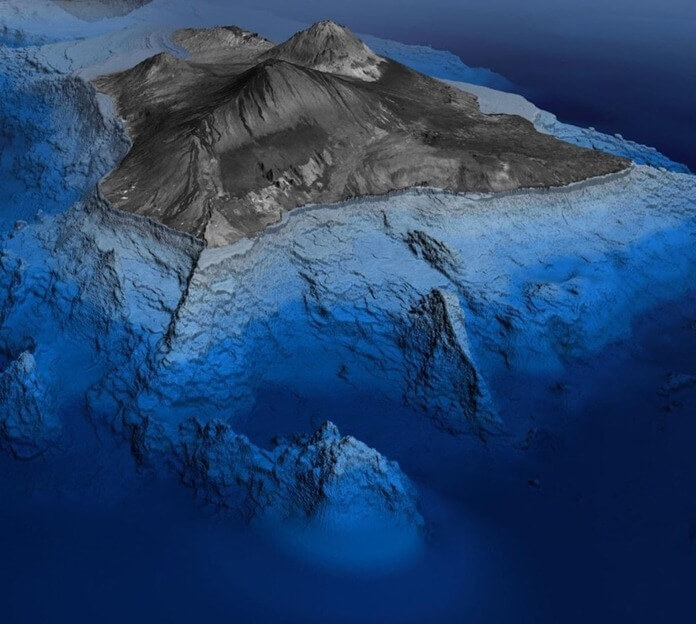 «Сестра» Мауна-Лоа возвышается почти на 4 267 м над уровнем моря. Вроде бы немного, верно? Однако в Мауна-Кеа скрыто больше потенциала, чем кажется на первый взгляд – ее основание находится глубоко под толщей вод на глубине более 6 000 м. Это делает Мауна-Кеа самой высокой горой в мире. Если бы она была полностью расположена на суше, она бы побила рекорд всех самых высоких вулканов мира, обойдя «наземного» фаворита Охос-дель-Саладо почти на 3 000 м.
«Сестра» Мауна-Лоа возвышается почти на 4 267 м над уровнем моря. Вроде бы немного, верно? Однако в Мауна-Кеа скрыто больше потенциала, чем кажется на первый взгляд – ее основание находится глубоко под толщей вод на глубине более 6 000 м. Это делает Мауна-Кеа самой высокой горой в мире. Если бы она была полностью расположена на суше, она бы побила рекорд всех самых высоких вулканов мира, обойдя «наземного» фаворита Охос-дель-Саладо почти на 3 000 м.
На вершине Мауна-Кеа очень низкая влажность и практически никогда не бывает облаков – теперь там расположена одна из самых больших обсерваторий в мире.
 Мауна-Кеа возникла над горячей точкой земли – места, где из мантийного слоя Земли поднимается вверх раскаленная и расплавленная магма. В течение миллионов лет исходящая наружу расплавленная порода создавала поверхность всего гавайского архипелага. Мауна-Кеа – спящий вулкан; это значит, что он неактивен уже более 4 000 лет, а горячая точка выхода магмы на поверхность сместилась. Однако бездействие вовсе не значит, что он будет дремать вечно.
Мауна-Кеа возникла над горячей точкой земли – места, где из мантийного слоя Земли поднимается вверх раскаленная и расплавленная магма. В течение миллионов лет исходящая наружу расплавленная порода создавала поверхность всего гавайского архипелага. Мауна-Кеа – спящий вулкан; это значит, что он неактивен уже более 4 000 лет, а горячая точка выхода магмы на поверхность сместилась. Однако бездействие вовсе не значит, что он будет дремать вечно.
1. Самый большой вулкан в мире: Массив Таму — 4000 метров
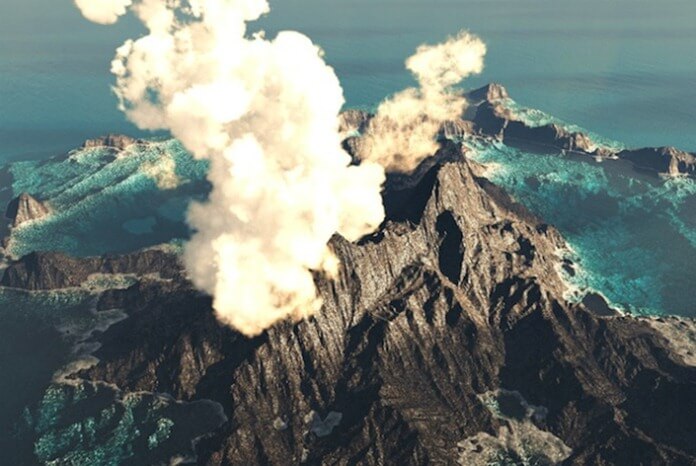 «Как, всего 4000 метров — и самый большой вулкан в мире?» — может возмутиться читатель. Да, высота Таму не слишком впечатляет. Но давайте рассмотрим его поподробнее со всех сторон.
«Как, всего 4000 метров — и самый большой вулкан в мире?» — может возмутиться читатель. Да, высота Таму не слишком впечатляет. Но давайте рассмотрим его поподробнее со всех сторон.
Большинство самых больших природных объектов мира человечество обнаружило давно, еще на заре своего существования. Но массив Таму – самый огромный вулкан на планете Земля – долгие годы ухитрялся скрываться от людей.

Поразительно, что человечество больше знало о громадных вулканах на Марсе, чем о гигантской горе под самым носом. Причина тому как отдаленное местоположение (находится он на 1 600 с лишним км на восток от Японии), так и глубина. Его вершина погружена в толщу Мирового океана на 2 000 км. И только в 2013 году ученые выяснили, что поражающая воображение гора лавы на дне океана — на самом деле один-единственный вулкан.

Объем его приблизительно равен 2,5 млн. км3, а площадь более чем 311 км2. К счастью, он давно спит – последнее извержение Таму было около 144 миллиона лет назад.
Самый опасный вулкан в мире
 Супервулкан Йеллоустоун считается самым активным и опасным на сегодня. Находящийся в национальном парке США, он представляет огромную угрозу не только для штата Вайоминг, но и для всей планеты. Считается что извержение Вулкана Йеллоустоун может привести к изменению климата на всей Земле.
Супервулкан Йеллоустоун считается самым активным и опасным на сегодня. Находящийся в национальном парке США, он представляет огромную угрозу не только для штата Вайоминг, но и для всей планеты. Считается что извержение Вулкана Йеллоустоун может привести к изменению климата на всей Земле.

В результате катастрофы будет уничтожено более 70% территории США. Магма и пелел покроют территорию 3-метровым слоем. Потери составят более 10 миллионов жизней, а территория превратится в необитаемую из-за высокого уровня радиации.

Сегодня посещение парка ограничено, на некоторые территории полностью запрещен въезд. Ученые тщательно исследуют кальдеру, извержение может начаться в ближайшие десятилетия.
📚 Не пропустите интересную информацию:
-
Астропрогноз на разрыв отношений в 2026 году: какие знаки зодиака склонны больше всего
Если ты когда-нибудь просыпался с мыслью: «А вдруг мы не пара?» — ты не один. Любовь — это не только свечи, пледы и «я тебя... -
Мини-отели против больших гостиниц: в чем преимущества?
Не всем по душе атмосфера крупных гостиниц. Коридоры, где эхо шагов звучит громче приветствий. Лобби, в которых всегда кто-то торопится, а персонал, хоть и вежлив,... -
Продукты, содержащие магний: в каких продуктах больше всего магния, почему это важно?
Магний входит в число минералов, необходимых нашему организму для здоровой жизни . Магний, который играет важную роль во многих важных аспектах, от функционирования наших мышц... -
Почему женщины испытывают большее отвращение к грязным вещам?
Кто более дотошен, мать или отец? Кто злится больше, когда вы приходите домой грязным или оставляете посуду в комнате? Почему женщины испытывают больше отвращения? Исследования... -
От Неаполя до Кагосимы: города, находящиеся в опасной близости от вулканических гор
Вулканы всегда казались природными чудесами, которые одновременно вызывали благоговение и вызывали огромные разрушения на протяжении всей истории человечества. От Везувия, уничтожившего древний город Помпеи ,...

